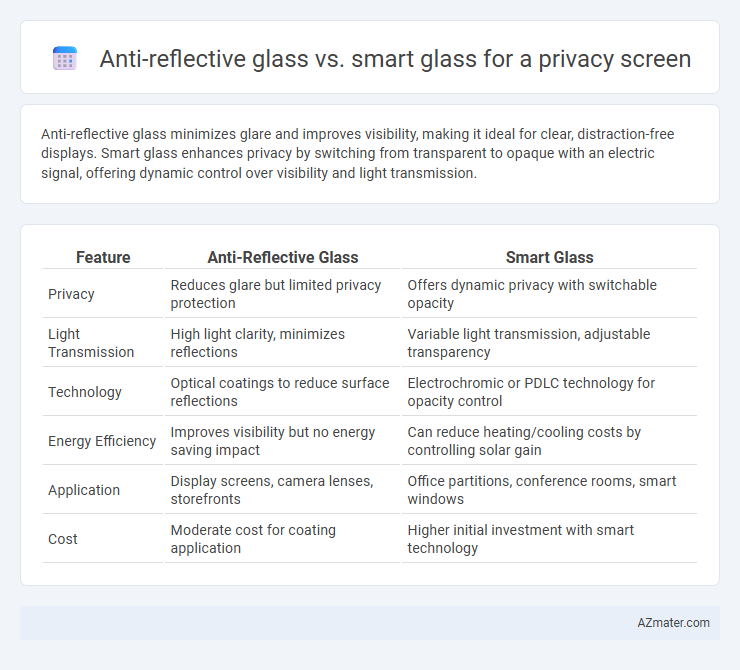Anti-reflective glass minimizes glare and improves visibility, making it ideal for clear, distraction-free displays. Smart glass enhances privacy by switching from transparent to opaque with an electric signal, offering dynamic control over visibility and light transmission.
Table of Comparison
| Feature | Anti-Reflective Glass | Smart Glass |
|---|---|---|
| Privacy | Reduces glare but limited privacy protection | Offers dynamic privacy with switchable opacity |
| Light Transmission | High light clarity, minimizes reflections | Variable light transmission, adjustable transparency |
| Technology | Optical coatings to reduce surface reflections | Electrochromic or PDLC technology for opacity control |
| Energy Efficiency | Improves visibility but no energy saving impact | Can reduce heating/cooling costs by controlling solar gain |
| Application | Display screens, camera lenses, storefronts | Office partitions, conference rooms, smart windows |
| Cost | Moderate cost for coating application | Higher initial investment with smart technology |
Introduction to Privacy Screen Technologies
Privacy screen technologies include anti-reflective glass and smart glass, each offering unique benefits for reducing visibility and glare. Anti-reflective glass uses coatings to minimize reflections and enhance screen clarity, ideal for preventing unwanted viewing in bright environments. Smart glass employs electrochromic or polymer-dispersed liquid crystal (PDLC) technology to switch from transparent to opaque, providing dynamic and customizable privacy control.
What Is Anti-Reflective Glass?
Anti-reflective glass is engineered with specialized coatings that minimize surface reflections, enhancing transparency and improving visibility in high-glare environments. This type of glass reduces light reflection by up to 99%, making it ideal for display screens, windows, and optical devices where clarity is critical. Unlike smart glass, which uses electrochromic technology to change opacity, anti-reflective glass focuses solely on reducing glare without altering the glass's transparency for privacy.
What Is Smart Glass?
Smart glass, also known as switchable glass, uses electrochromic, suspended particle, or liquid crystal technology to control light transmission and opacity, providing adjustable privacy on demand. Unlike anti-reflective glass, which reduces glare by minimizing surface reflections, smart glass can change from transparent to opaque with an electrical signal, offering dynamic privacy control. Its ability to modulate light and visibility makes smart glass a versatile solution for privacy screens in offices, homes, and healthcare settings.
Core Functionality: Anti-Reflective vs. Smart Glass
Anti-reflective glass reduces glare and reflections by using special coatings that enhance visibility and clarity, making it ideal for screens in bright environments. Smart glass, also known as switchable glass, changes its opacity electronically to provide instant privacy or transparency on demand, offering dynamic control over screen visibility. The core functionality difference lies in anti-reflective glass improving visual comfort, while smart glass enables active privacy control through adjustable translucency.
Privacy Performance Comparison
Anti-reflective glass minimizes glare and enhances visibility but offers limited privacy protection, as it does not obstruct views from either side. Smart glass uses electrochromic technology to switch from transparent to opaque, providing dynamic privacy control and superior privacy performance by preventing external viewing when activated. In terms of privacy screening, smart glass outperforms anti-reflective glass by allowing users to actively control visibility and block sightlines effectively.
Light Transmission and Visual Clarity
Anti-reflective glass enhances light transmission by minimizing surface reflections, ensuring high visual clarity and reducing glare for optimal privacy screen performance. Smart glass adjusts its opacity electronically, modulating light transmission to switch between transparent and frosted states, which directly controls privacy but can reduce overall clarity when opaque. Light transmission in anti-reflective glass remains consistently high, while smart glass offers variable transmission with potential slight diffusion affecting sharpness in privacy mode.
Durability and Maintenance Factors
Anti-reflective glass offers high durability with a hard coating that resists scratches and reduces glare, making it low-maintenance and long-lasting for privacy screen applications. Smart glass, while providing dynamic opacity control for enhanced privacy, requires more careful maintenance due to its sensitive electronic components and may have a shorter lifespan if exposed to harsh conditions. Both options balance privacy and durability differently, with anti-reflective glass favoring robustness and smart glass favoring flexible privacy management.
Energy Efficiency and Environmental Impact
Anti-reflective glass enhances privacy screen performance by reducing glare and improving visibility while maintaining energy efficiency through better natural light utilization. Smart glass offers superior privacy control with adjustable opacity, contributing to energy savings by reducing the need for artificial lighting and climate control. Environmentally, smart glass's dynamic features lower energy consumption over time, whereas anti-reflective glass relies on passive optical improvements, making smart glass a more sustainable choice for energy-conscious applications.
Cost Analysis: Upfront and Long-Term
Anti-reflective glass typically has a lower upfront cost compared to smart glass, which requires more advanced technology and installation processes. Over time, smart glass may incur higher maintenance expenses, but it offers significant energy savings due to its ability to control light and heat transmission, potentially reducing HVAC costs. In contrast, anti-reflective glass generally demands less ongoing maintenance but lacks the dynamic privacy and energy efficiency benefits of smart glass.
Choosing the Best Glass Solution for Privacy Screens
Anti-reflective glass enhances visibility by reducing glare and reflections, making it ideal for environments requiring clear views without distortion. Smart glass offers dynamic privacy control by electronically adjusting transparency, allowing users to switch between transparent and opaque states instantly. When choosing the best glass solution for privacy screens, consider the specific need for constant privacy versus flexibility, with anti-reflective glass suited for static environments and smart glass favored for adaptive, on-demand privacy.

Infographic: Anti-reflective glass vs Smart glass for Privacy screen
 azmater.com
azmater.com